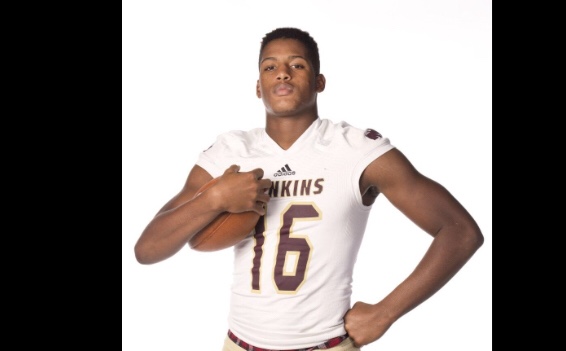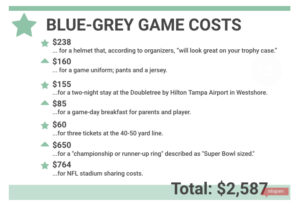
LAKELAND —Jordan Domineck plans to play his college football close to home. The George Jenkins senior, one of the county’s top defensive players this past season, is verbally committed to the University of South Florida.
Domineck helped lead the Eagles to six wins this year. It was the school’s best season in seven years. Late in October, he received a letter in the mail. It was an invitation to play in the Blue-Grey All-American Bowl at Raymond James Stadium in Tampa.
The Blue-Grey game is one of the many all-star football games for graduating high school seniors.
“My dream was to play in an All-American game,” Domineck said. “George Jenkins, we’ve got some of the best players coming through. I’m trying to get George Jenkins back on the map.”
It takes more than talent to play in the Blue-Grey game, though.
The cost for the 2017 game in Tampa, one Domineck and Jenkins teammate Vance Jayden Monroe hope to play in, is $2,587. The Blue-Grey organization says the cost to produce the event is “over $325,000.”
Sean Ceglinsky, Blue-Grey Football’s media director, said the game does have scholarship packages to help some players pay for the game. Neither Jenkins player received that, though Domineck’s costs have been covered through sponsorship by people in the community.
“What we’re providing is a platform for these young men to come play in an NFL stadium with NFL veteran coaches and be on a nationally broadcasted game,” Ceglinsky said. “It’s no secret that there’s a money aspect to it, but that’s just to cover the cost of the stadium and stuff like that.”
The combined cost for Domineck and Monroe to play would be $5,174. Included within that, excluding a $475 deposit to lock down a spot on the roster, are an array of expenses:
‒ $238 for a helmet that, according to organizers, “will look great on your trophy case.”
‒ $160 for a game uniform; pants and a jersey.
‒ $155 for a two-night stay at the Doubletree by Hilton Tampa Airport in Westshore.
‒ $85 for a game-day breakfast for parents and player.
‒ $60 for three tickets at the 40-50 yard line.
‒ $650 for a “championship or runner-up ring” described as “Super Bowl sized.”
Each player is also asked to pay $764 to cover the cost of playing the game in an NFL team’s stadium.
Rosters feature 54 players each. And, between the two teams, those players will pay $85,512 in stadium costs. The total expenses for 108 players will total $279,396, which comes out to about 86 percent of the “over $325,000” cost of the event.
“As with any growing company, you kind of have to walk before you run now,” Ceglinsky said. “Now that we’ve had ESPN come into the fold, I think that’ll give us the opportunity to find a potential major sponsor for the All-American bowl.
“Once we sign that, I think that game changes a little bit and there’ll be more resources for these young men to come in and play once we have a major title sponsor.”
Exposure or experience?
With his commitment to USF, Domineck is going for the exposure.
He was rated a three-star recruit by most recruiting services, and he wants to prove to coaches and players in attendance that he’s better than that. Domineck is one of the lucky ones. He has an offer to play at an NCAA Division I school.
Johnathan Vega was still searching for that big offer.
The former Ridge Community offensive lineman played in the Blue-Grey game last year. He spent this past season at Independence Community College in Kansas and said he has accepted an offer to continue his career at Division II Lincoln University of Missouri.
“It wasn’t even about the exposure. I couldn’t have honestly cared less about the exposure, to be honest,” Vega said. “I just went there to have fun and it being basically my last high school game I would ever play, I just know that no one can take that away from me.”
With the Blue-Grey game, players are invited to play in one last prep game, teaming with other prospects from across the country. The games are normally played in bigger cities, most times in an NFL stadium.
“I think that we’ve found our niche,” Ceglinsky said, “We’re happy with where we’re at in the grand scheme of things. We want to help open doors and provide exposure.”
The other games
Blue-Grey Football began in 1989, but the game has only existed since 2014.
The organization remains a step behind two of its bigger counterparts: The Under Armour High School All-America Game and the U.S. Army All American Bowl.
Between those two games, fans will find most if not all of the top-ranked prospects in the country. The Under Armour and U.S. Army games are broadcast nationally on ESPN and NBC, respectively.
The Blue-Grey’s Florida games are streamed online through ESPN3.
The Army game is held annually at the Alamodome in San Antonio, Texas, while the Under Armour game is played annually in Florida at Tropicana Field in St. Petersburg and, as of last year, Camping World Stadium in Orlando.
Fort Meade senior Cleveland Reed is the latest Polk prospect to play in the Under Armour game. Neither game is a pay-to-play event. Player expenses are covered by game officials.
Lakeland assistant coach Will Bahler, who coached in the Under Armour game last year with former Dreadnaughts’ James Robinson and A.J. Davis, said his guys did not pay anything. He added that the game sent a driver to pick them up and drive them to Orlando since it was so close.
“Anytime you have to pay to participate in an all-star game, especially one that is supposed to be All-America with a cost that high, it makes no sense,” said Hasani Harper, the owner of H2 Athletes. “They try to pitch exposure, but who watches those games? How many college coaches actually sit and watch those games on TV or streamed online like Blue-Grey is? I haven’t heard of any who do.”
Harper knows the recruiting circuit well. His business is a paid service for athletes looking to be noticed on the recruiting circuit. It does that by creating highlight reels and developing a network of college coaching and scouting contacts.
“If you can’t pay the cost, they go to the next person up who can afford it,” he said. “If you are choosing the best of the country but are passing on the ones who can’t pay and calling the ones who can All-Americans, are they really the best of the country or the best available who could afford to pay?”
Is it worth it?
There are four Blue-Grey All-American Bowl games in December and January.
There’s the game in Tampa at Raymond James Stadium, but there will also be a game one week later in Jacksonville at EverBank Field on Jan. 13.
Two games are played in Dallas at AT&T Stadium, the first on Dec. 18 and the second on Jan. 22. Both pit the East vs. the West, though the team rosters are different in each game. In all, 216 players will be Blue-Grey All Americans in 2017. Some will have their entry into the game paid. Most will pay about $2,500 each.
Some will see their recruitment increase after they run 15 plays in the game. Most will relish the rare chance to play in an NFL stadium.
To Vega, who played in last year’s Blue-Grey game, it was worth it.
“How many people can say, for an entire weekend I was running through basically an NFL practice getting ready for this game? We got to play in an NFL stadium. How many people can say that?” Vega said. “I wouldn’t have change that experience at all for anything.”

Article Credit: Brady Fredericksen brady.fredericksen@theledger.com or 863-802-7553. http://www.theledger.com


